Hazels, Filberts, Cobnuts; Good by any Name
Nuts are Good
Let’s talk about nuts. No, not about nutty politics, but about real nuts such as fall from trees and shrubs. (Peanuts are borne on a small, annual plant, but despite their name, are legumes, not true nuts.) Nuts are an overlooked food. For all you protein people, nuts are high in protein, and, for all you heart-healthy people, they’re high in the good kinds of fatty acids. I eat them because, unadulterated, they’re good-tasting and generally good for you.

Ripe filbert nuts
Nuts are not difficult to grow, and can make attractive dual-purpose plants as both edibles and as ornamentals.
Black walnuts are especially easy. Squirrels do the planting for me; my job is to get rid of excess trees, of which there are plenty sprouting all over the place. The next job with walnuts, after gathering them up, is getting at the nutmeat. Well worth the effort, in my opinion, but that’s a story for another time.
Filbert in Variety
Filberts are easy to grow and easy to shell. Because of a disease known as eastern filbert blight, the trick in growing them here in the Northeast is selecting an appropriate variety. (“Hazelnut” is another name for filberts, as is, In Britain, “cobnut.“) Filbert blight is an indigenous disease east of the Rocky Mountains. First symptoms are elliptical black stromata along stems.
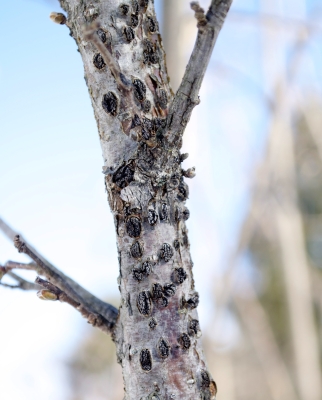
Pustules of filbert blight
The disease kills individual branches, even whole plants. I first planted filberts many years ago and was told it could take 10 years for the disease to show up; disappointingly, that was true.
Susceptibility to filbert blight varies. Our native American filbert (Coryllus americana) evolved with the disease so is resistant. Unfortunately, it generally bears nuts that are very small and not very tasty. European filberts (C. avellana), the filberts of commerce, bear large, tasty nuts, but are susceptible to filbert blight.
Decades of breeding at universities and by individual nut enthusiasts sought the holy grail: Filbert plants that bear large, tasty nuts and that fend off filbert blight. Filbert blight’s inroads into the Pacific northwest, where filberts are grown commercially spurred development of a number of blight resistant varieties at Oregon State University (OSU). I’ve tried a number of them, including Jefferson, Lewis, Clark, Santiam, Yamhill, Dorris, and Theta. Problem is that the filbert blight fungus has a nasty habit of appearing in more than one strain so that a variety resistant in one place can be susceptible elsewhere. All those OSU varieties, with the exception of Dorris and Yamhill succumbed to blight here.
Over the years, I’ve also planted other varieties. Gellatly, Halls Giant, and Tonda di Giffoni were promising, and bore large, tasty nuts for a few years before succumbing to blight. 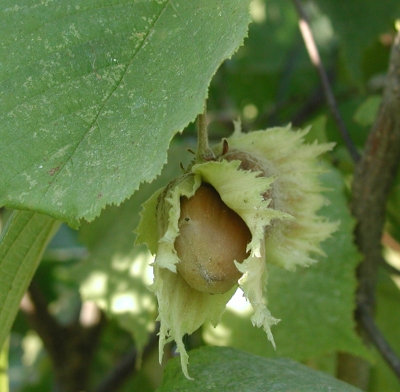 Five years ago, I had the opportunity to test some of the varieties from Dr. Tom Molnar’s filbert breeding program at Rutgers University; these plants are now old enough to bear. Being test plants, they have unappetizing names like CR x R11P07 and CR x RO3P26. Mmmm. I’m sure they mean something to Tom.
Five years ago, I had the opportunity to test some of the varieties from Dr. Tom Molnar’s filbert breeding program at Rutgers University; these plants are now old enough to bear. Being test plants, they have unappetizing names like CR x R11P07 and CR x RO3P26. Mmmm. I’m sure they mean something to Tom.
All of which is to say that I have a good reservoir of blight fungus floating around here as well as a number of varieties to evaluate for yield, nut quality (which, at this point, is mostly about size), and resistance to filbert blight. Drum roll . . . The winners, so far, are CR x R11P10, CR x RO3P26, CR x R06P56, Yamhill, and Graham. None of the “CR” varieties show any blight and all have good nut size. The heaviest yield is from CR x RO3P26.
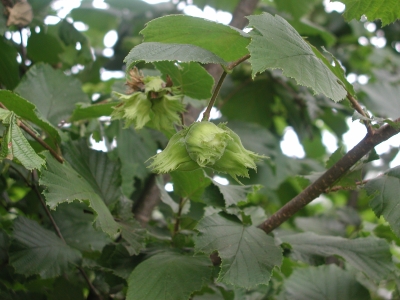 Yamhill always has some blight but still manages to bear nuts, small to medium-sized ones.
Yamhill always has some blight but still manages to bear nuts, small to medium-sized ones.
The last one named, Graham, is from my original planting of 20 years ago. Its suckering growth habit evokes its American filbert parentage. (European filberts hardly spread by suckers, growing instead as large bushes or medium-sized trees.) Graham always has a number of blighted branches yet always bears good crops of large, tasty nuts.
Also in the pipeline are MacDonald (from OSU), Truxton, and Geneva (also known as Gene, and from www.grimonut.com and www.znutty.com). Filberts typically bear in their third or fourth year so I won’t be waiting long before seeing if any of these varieties are keepers.
Enter: Squirrels
Filberts are delicious, and growing and cracking them is easy; the fly in the ointment is squirrels. They will strip a bush clean. Besides, or in addition to, the usual methods for thwarting squirrels — dogs, cats, guns, and traps — are other options.
Sufficiently isolated plants, if grown as single-trunked trees and trained so that no branches droop or originate lower than 6 to 8 ft. from ground level, can be protected. Either a 2 ft. cylinder or an inverted cone of sheet metal wrapped around the trunk 6 to 8 feet above ground level does the trick.
Hot pepper spray?
Harvesting the almost-ripe nuts before squirrels get to them?
I’ve found that squirrels avoid running in high grass, probably because it slows them down, and they need all the speed they can get with my dogs present. Then again, maybe they’re just hidden from me in the high grass. Still, thus far squirrels have avoided my filberts in my once-a-year mowed meadow.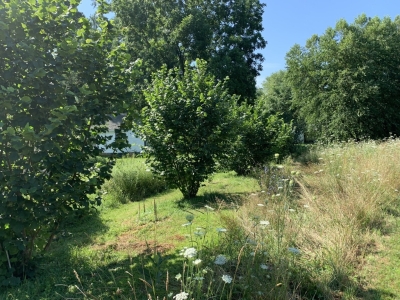


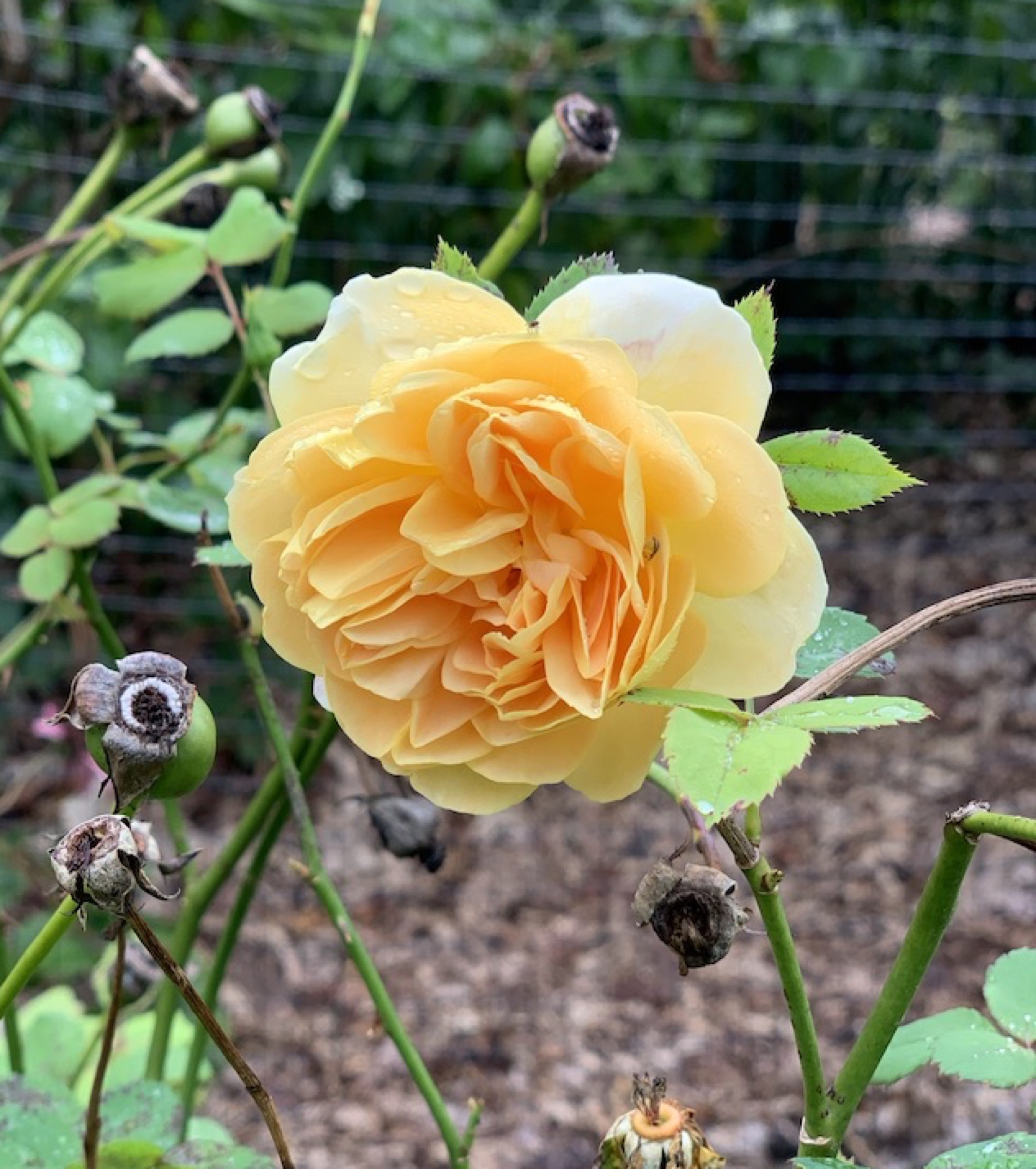

What is a good source for the trees that hold promise?
http://www.raintreenursery.com, znutty.com, http://www.burntridgenursery.com
Thanks so much for the information – I will research the varieties you listed.
I’m curious as to whether you have tried the Hazelbert (“Developped in New York State by Fred Ashworth in the 1920’s, the Hazelbert is a cross between Graham and Wrinkler (both Corylus americana orginating from USA) and Skinner (a cross from Corylus americana from Manitoba and Corylus avellana Italian Red Filbert”) ?
Living in Vermont I’m thinking about trying it in my zone (4a or 4b) yard but am uncertain as to which tree is best here for nuts, long straight branches (for garden supports etc.), and wildlife. I believe I should get the Corylus americana for nativeness but would also love good tasting nuts. ..
I never tried the hazelberts. I have grown Corylus americana; generally, they’re very pretty in fall but the nuts that I tasted were small and not very tasty. There may be some better ones out there.
Where can I buy seeds of these recommended varieties this Fall for stratifying and starting plants in Northwest Michigan?
Thank you
First, be aware that planting seeds will not give you a clone of whatever variety the seed came from. Then I would suggest contacting the Northern Nut Growers Association (nutgrowing.org), nafex.org, and commercial hazel nurseries such as nutty.com, and badgersett.com.